Birdfinding.info ⇒ One of the commonest breeding songbirds in the eastern U.S., especially in a band that extends from the upper Midwest east through the Ohio Valley to the mid-Atlantic states and southern New England, where it is ubiquitous in semiopen habitats that include patches of dense brush. In winter and migration periods it is very numerous in all the territories adjacent to the Gulf of Mexico.
Gray Catbird
Dumetella carolinensis
Breeds in central and eastern North America. Winters in the eastern U.S. and Middle America.
Breeding. Breeds from late May to August in riparian and other deciduous woodlands with dense understory from southwestern and central British Columbia east across southern Canada to Newfoundland and south through the interior of the Pacific Northwest and Rocky Mountain states to southern Utah and central New Mexico, on the Great Plains south to Oklahoma, and generally throughout the eastern U.S. south to eastern Texas and northern Florida.
Also breeds on Bermuda, which has a resident population.
Nonbreeding. Winters in the eastern U.S. along the Eastern Seaboard from Massachusetts to Florida, then west and south along the Gulf of Mexico coastal plain through the Yucatán Peninsula and Caribbean slope of Central America to western Panama, sparingly to the Caribbean lowlands of Colombia.
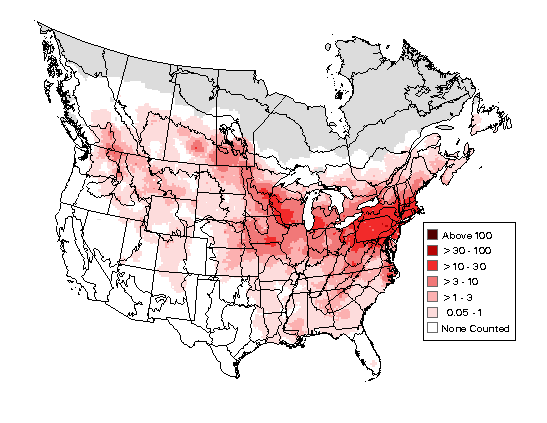
Breeding Bird Survey Abundance Map: Gray Catbird. U.S. Geological Survey 2015
In the West Indies, winters commonly on the Bahamas, Cuba, Jamaica, and the Caymans, and in smaller numbers east to Puerto Rico.
Scattered stragglers regularly winter outside the usual range, essentially throughout the U.S., Mexico, Central America, and elsewhere in the West Indies.
Movements. Northbound migration begins around early April and is mostly complete by mid-May. Most migrants follow the Gulf of Mexico coastal plain into eastern Texas. Much smaller but substantial numbers migrate north from the West Indies or Yucatán Peninsula to Florida and follow the Eastern Seaboard north.
Southbound migration begins in August and continues through October.
Spring overshoots are fairly frequent, including multiple records from Alaska, the Yukon, the Northwest Territories, northern Quebec, and Labrador.
It has been recorded several times as a fall vagrant to western Europe—with records from Belgium, the Channel Islands, England, Germany, Ireland, and Wales.
Identification
Familiar and distinctive: a small thrasher that is uniformly lead-gray with a black cap, black tail, and chestnut undertail coverts.

Gray Catbird. (Paget Marsh, Bermuda; March 14, 2021.) © LeShun Smith

Gray Catbird, far north of its usual range. (Whitehorse, Yukon; September 24, 2020.) © Cameron Eckert
The tail is long and has a rounded tip, often held partly fanned, especially when singing.
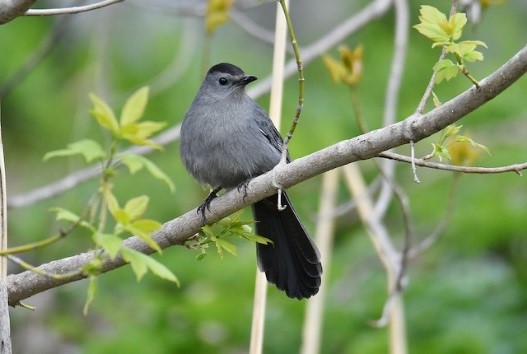
Gray Catbird, showing its broad, round-tipped tail. (Stephen-Langevin Arboretum, Boucherville, Quebec; May 12, 2017.) © André Lanouette

Gray Catbird, showing its chestnut undertail coverts. (Dos Naciones, Calakmul Biosphere Reserve, Campeche, Mexico; January 3, 2018.) © Daniel Garza Tobón
Notes
Monotypic species.
Additional Photos of Gray Catbird
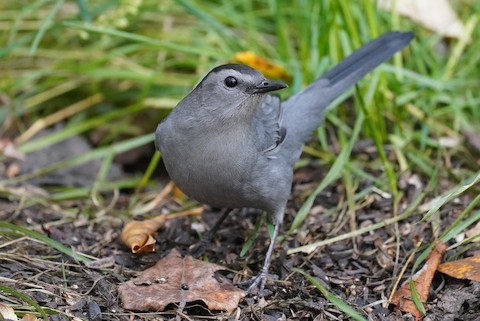
Gray Catbird. (Whitehorse, Yukon; September 24, 2020.) © Cameron Eckert
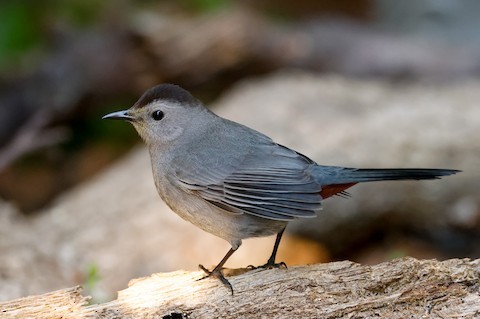
Gray Catbird. (Savannah, Georgia; April 26, 2021.) © Peter Schreck
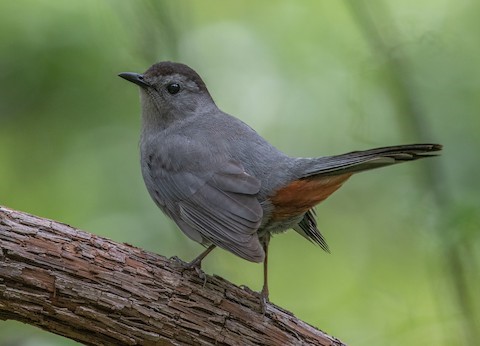
Gray Catbird. (Shell Mound Park, Dauphin Island, Alabama; April 20, 2021.) © Iris Kilpatrick
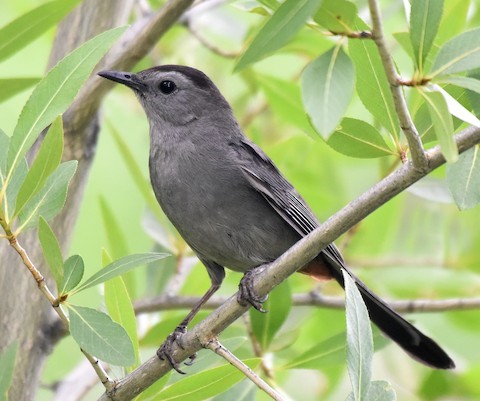
Gray Catbird. (Loudy-Simpson Nature Trail, Moffat County, Colorado; July 3, 2017.) © Steven Mlodinow
References
Alderfer, J., and J.L. Dunn. 2014. National Geographic Complete Birds of North America (Second Edition). National Geographic Society, Washington, D.C.
BirdLife International. 2016. Dumetella carolinensis. The IUCN Red List of Threatened Species 2016: e.T22711013A94272855. https://dx.doi.org/10.2305/IUCN.UK.2016-3.RLTS.T22711013A94272855.en. (Accessed December 31, 2021.)
Brewer, D., and B.K. MacKay. 2001. Wrens, Dippers, and Thrashers. Yale University Press.
eBird. 2021. eBird: An online database of bird distribution and abundance. Cornell Lab of Ornithology, Ithaca, N.Y. http://www.ebird.org. (Accessed December 31, 2021.)
Fagan, J., and O. Komar. 2016. Peterson Field Guide to the Birds of Northern Central America. Houghton Mifflin Harcourt, New York.
Garrigues, R., and R. Dean. 2014. The Birds of Costa Rica: A Field Guide (Second Edition). Cornell University Press.
Haynes-Sutton, A., A. Downer, R. Sutton, and Y.-J. Rey-Millet. 1986. A Photographic Guide to the Birds of Jamaica. Princeton University Press.
Howell, S.N.G., and S. Webb. 1995. A Guide to the Birds of Mexico and Northern Central America. Oxford University Press.
Kirwan, G.M., A. Levesque, M. Oberle, and C.J. Sharpe. 2019. Birds of the West Indies. Lynx Edicions, Barcelona.
Latta, S., C. Rimmer, A. Keith, J. Wiley, H. Raffaele, K. McFarland, and E. Fernandez. 2006. Birds of the Dominican Republic and Haiti. Princeton University Press.
McMullan, M., and T. Donegan. 2014, Field Guide to the Birds of Colombia (Second Edition). Fundación Proaves de Colombia, Bogotá.
Raffaele, H., J. Wiley, O. Garrido, A. Keith, and J. Raffaele. 1998. A Guide to the Birds of the West Indies. Princeton University Press.
Ridgely, R.S., and J.A. Gwynne. 1989. A Guide to the Birds of Panama (Second Edition). Princeton University Press.
Ridgely, R.S., and G. Tudor. 1989. The Birds of South America, Volume I: The Oscine Passerines. University of Texas Press.
Salt, W.R., and J.R. Salt. 1976. The Birds of Alberta. Hurtig Publishers, Edmonton, Alberta.
Sibley, D.A. 2014. The Sibley Guide to Birds (Second Edition). Alfred A. Knopf. New York.
Svensson, L., K. Mullarney, and D. Zetterström. 2009. Birds of Europe (Second Edition). Princeton University Press.
Xeno-Canto. 2021. Grey Catbird – Dumetella carolinensis. https://xeno-canto.org/species/Dumetella-carolinensis. (Accessed December 31, 2021.)

